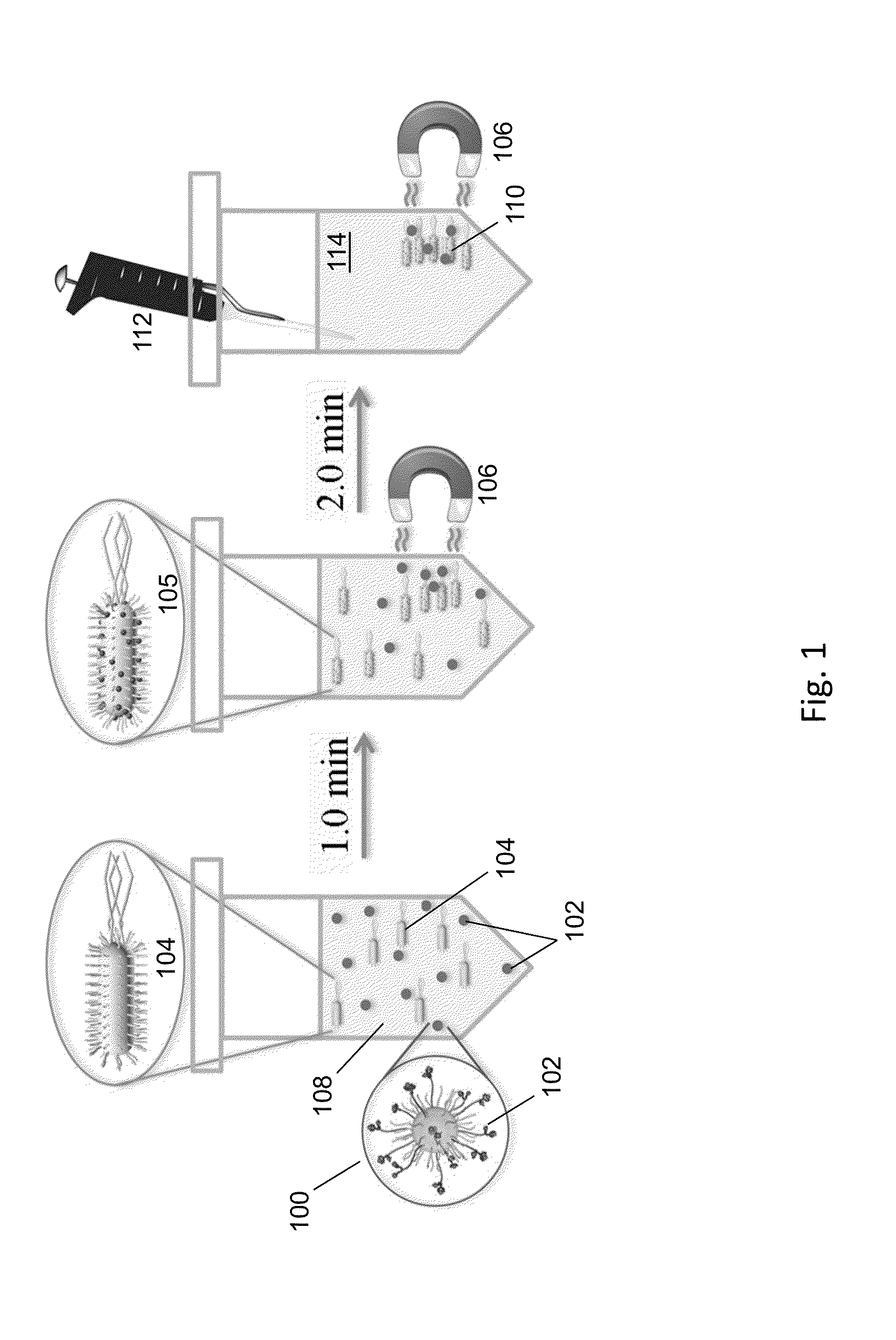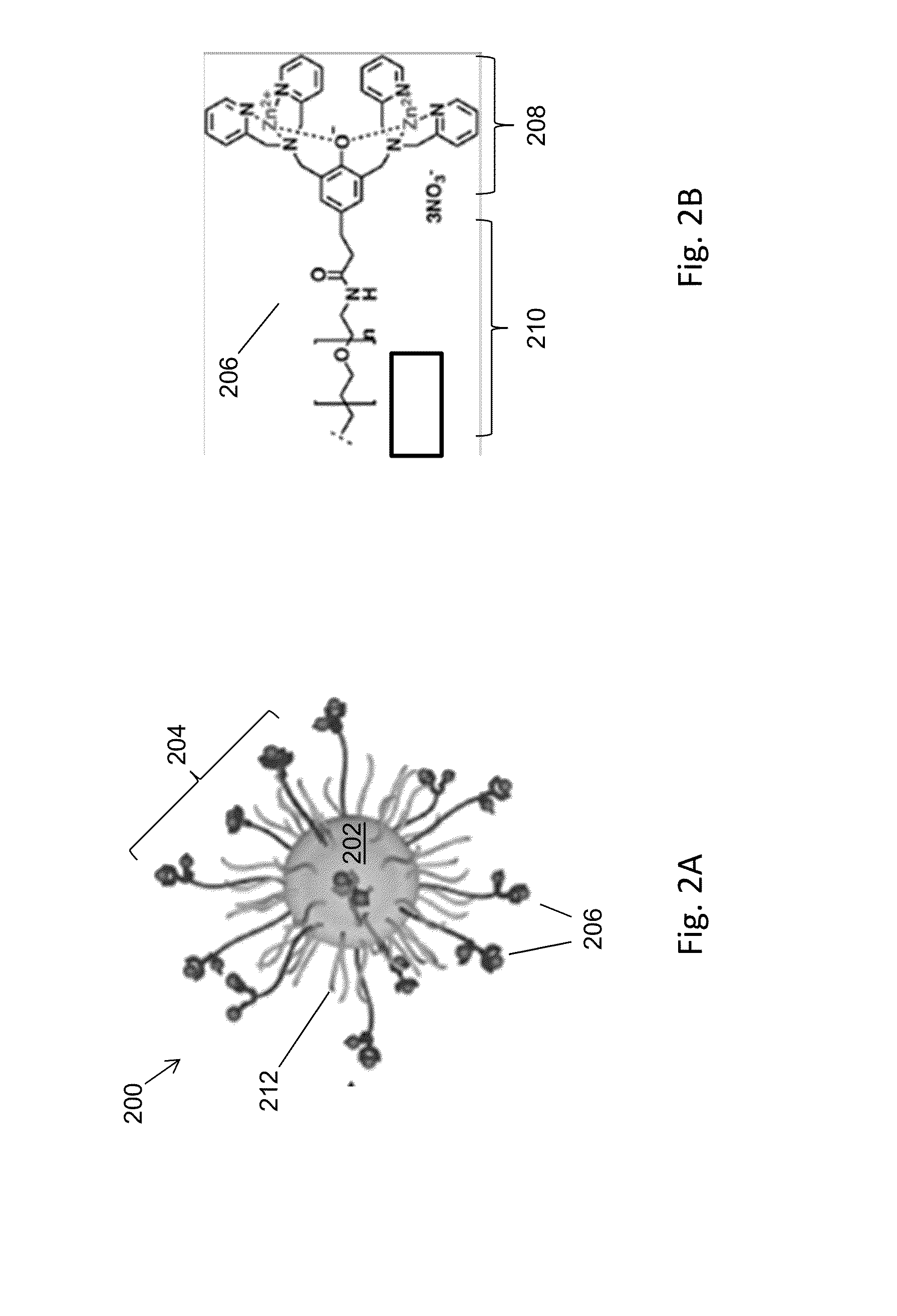Magnetic separation using nanoparticles
a technology of nanoparticles and magnetic separation, applied in the field of magnetic separation, can solve the problems of multiple organ dysfunction and death, and achieve the effects of short incubation time, high selective separation, and rapid binding between nanoparticles and target species
- Summary
- Abstract
- Description
- Claims
- Application Information
AI Technical Summary
Benefits of technology
Problems solved by technology
Method used
Image
Examples
example 1
Nanoparticle Synthesis and Characterization
[0076]FIG. 8A shows a scheme 800 for the preparation of magnetic nanoparticles modified with bis-DPA-PEG-Zn (referred to herein as NPPEG-DPA-Zn). Bis-DPA with a PEG (MW=10 kDa) spacer (bis-DPA-PEG-COOH) was immobilized on the surface of 100 nm diameter amine-terminated Fe3O4 magnetic nanoparticles (approximately 300 amines per nanoparticle, SiMAG-Amine particles, chemicell GmbH, Berlin, Germany) through carbodiimide chemistry using EDC and (sulfo-NHS). Excess bis-DPA-PEG-COOH was activated by N-hydroxysulfosuccinimide (sulfo-NHS) with EDC (10-fold molar excess each) and added to a solution of nanoparticles. The nanoparticle solution was washed twice with carbonate buffer (50 mM sodium carbonate, pH 9.5) using a magnetic separator (MagnetoPURE, chemicell GmbH). After 2 hours of reaction at room temperature, the modified nanoparticles were washed twice with carbonated buffer.
[0077]Unreacted free amines on the surface of the nanoparticles were...
example 2
Fluorescence Visualization of E. Coli Binding to Nanoparticles
[0083]Fluorescence-labeled E. coli were used to demonstrate the binding capability of NPPEG-DPA-Zn. A bacterial cell culture was prepared by inoculating 25 mL of standard lysogeny broth (LB) with E. coli (E. coli strain Stbl3, Life Technologies, Grand Island, N.Y.) using standard sterile technique. This culture was incubated for 12-18 hours at 37° C. and 5.0% CO2 and agitated at 200 RPM in an orbital shaker incubator overnight. Before using the bacteria for experiments, cells were pelleted by centrifugation at 2,000 g for 5 minutes. The supernatant was discarded and the cell pellet was resuspended in phosphate buffered saline (PBS). The concentration of E. coli was re-adjusted to be 1.0×109 CFU / mL (OD600=1.0).
[0084]To label the E. coli with the green fluorescent label SYTO 9™ (Life Technologies, Grand Island, N.Y.), which selectively labels live bacteria, the E. coli solution was incubated with 300× diluted SYTO 9 for 30 ...
example 3
Separation of E. Coli from a Buffer Solution
[0090]The efficiency of modified nanoparticles to separate a fixed concentration of E. coli (1.0×107 CFU / mL) by magnetic separation was measured in phosphate buffered saline (PBS) with varying concentrations of NPPEG-DPA-Zn DPA-Zn and NPPEG (from 0 to 1.0×1011 / mL). Each mixture of E. coli and nanoparticles was incubated in a 1.5 mL test tube for one minute at room temperature and a permanent magnet was placed on the side of the test tube for 2 minutes. 10 μL of the supernatant was collected and added to a cell counting chamber for analysis.
[0091]The number of bacteria in a 100× green fluorescence image of the supernatant was counted (using the NIH-provided freeware ImageJ) and converted to E. coli concentration in the solution. For this, a standard curve was generated that correlated the number of E. coli in the 100× green fluorescence image with the E. coli concentration in the solution (see below).
[0092]Referring to FIG. 11, a concentrat...
PUM
| Property | Measurement | Unit |
|---|---|---|
| molecular weight | aaaaa | aaaaa |
| flow rate | aaaaa | aaaaa |
| molecular weight | aaaaa | aaaaa |
Abstract
Description
Claims
Application Information
 Login to View More
Login to View More - R&D
- Intellectual Property
- Life Sciences
- Materials
- Tech Scout
- Unparalleled Data Quality
- Higher Quality Content
- 60% Fewer Hallucinations
Browse by: Latest US Patents, China's latest patents, Technical Efficacy Thesaurus, Application Domain, Technology Topic, Popular Technical Reports.
© 2025 PatSnap. All rights reserved.Legal|Privacy policy|Modern Slavery Act Transparency Statement|Sitemap|About US| Contact US: help@patsnap.com



